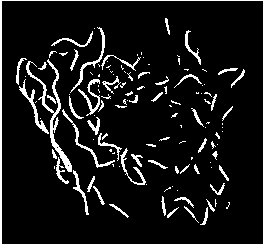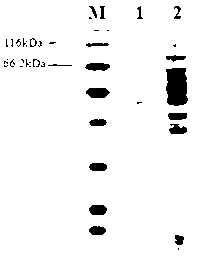Preparation method for single-chain antibody based on hybridoma cell
A hybridoma cell and single-chain antibody technology, which is applied in the field of single-chain antibody preparation, can solve the problems of increased blindness, difficult display efficiency, complex and inefficient preparation process of single-chain antibody, etc.
- Summary
- Abstract
- Description
- Claims
- Application Information
AI Technical Summary
Problems solved by technology
Method used
Image
Examples
Embodiment 1
[0045] Example 1 Preparation of single-chain antibody against RAC
[0046] 1. Cloning of Anti-RAC Antibody Variable Region Genes
[0047] RAC monoclonal hybridoma cell AC2 (preserved in our laboratory) was revived, and cultured in RPMI 1640 complete medium to 1×10 7 , Total RNA was extracted with Trizol (TAKARA Company) according to the manufacturer's instructions.
[0048] The total RNA was reverse-transcribed into the first strand of cDNA using a reverse transcription kit (Promega), following the manufacturer's instructions.
[0049] Use general-purpose primers to clone antibody heavy and light chain variable region genes. The general-type primers are shown in Table 1. Taking the light chain variable region gene cloning as an example, first mix the 6 primers of LF in equal proportions, and mix the LF primers separately. Combined with 19 primers from LB1~19 to form 19 primer sets, using the first strand of cDNA as a template, these 19 primer sets were used to amplify the ...
Embodiment 2
[0075] Example 2 Anti-furaltadone metabolites (Furazolidone Metabolite , AMOZ) single-chain antibody preparation
[0076] 1. Cloning of Anti-AMOZ Antibody Variable Region Gene
[0077] AMOZ monoclonal hybridoma cell 2BE (preserved in our laboratory) was revived and cultured in RPMI 1640 complete medium to 1×10 7 , Total RNA was extracted with Trizol (TAKARA Company) according to the manufacturer's instructions.
[0078] The total RNA was reverse-transcribed into the first strand of cDNA using a reverse transcription kit (Promega), following the manufacturer's instructions.
[0079] The heavy and light chain variable region genes of the AMOZ antibody were cloned using general-type degenerate primers. The general-type degenerate primers are shown in Table 1. The primer set screening method and the antibody gene cloning method were the same as in Example 1.
[0080] The screened primer combinations are: HB1-HF3, HB9-HF3, HB15-HF3, HB16-HF6, HB17-HF6, LB18-LF5, LB10-LF6, LB1...
Embodiment 3
[0106] Example 3 Preparation of single-chain antibody against OPs
[0107] 1. Cloning of Antibody Variable Region Genes Against OPs
[0108] After resuscitating OPs monoclonal hybridoma cell 12C2 (preserved in our laboratory), expand the culture in RPMI 1640 complete medium to 1×10 7 , Total RNA was extracted with Trizol (TAKARA Company) according to the manufacturer's instructions.
[0109] The total RNA was reverse-transcribed into the first strand of cDNA using a reverse transcription kit (Promega), following the manufacturer's instructions.
[0110] The heavy and light chain variable region genes of the OPs antibody were cloned using general-type degenerate primers. The general-type degenerate primers are shown in Table 1. The primer set screening method and the antibody gene cloning method were the same as in Example 1.
[0111] The screened primer combinations are: HB1-HF4, HB8-HF4, HB9-HF4, HB12-HF4, HB15-HF4, HB18-HF4, LB1-LF1, LB5-LF2, LB11-LF1, LB17-LF1, LB17-LF2...
PUM
 Login to View More
Login to View More Abstract
Description
Claims
Application Information
 Login to View More
Login to View More - R&D
- Intellectual Property
- Life Sciences
- Materials
- Tech Scout
- Unparalleled Data Quality
- Higher Quality Content
- 60% Fewer Hallucinations
Browse by: Latest US Patents, China's latest patents, Technical Efficacy Thesaurus, Application Domain, Technology Topic, Popular Technical Reports.
© 2025 PatSnap. All rights reserved.Legal|Privacy policy|Modern Slavery Act Transparency Statement|Sitemap|About US| Contact US: help@patsnap.com



